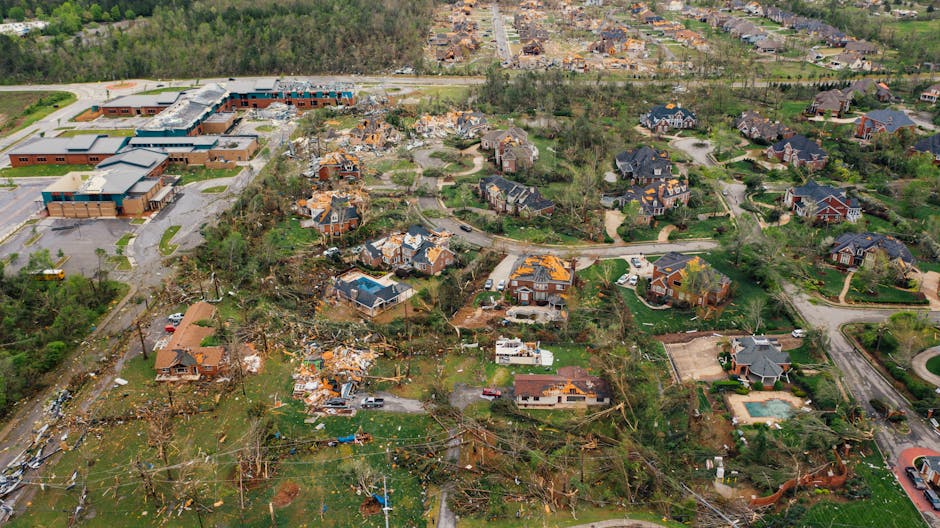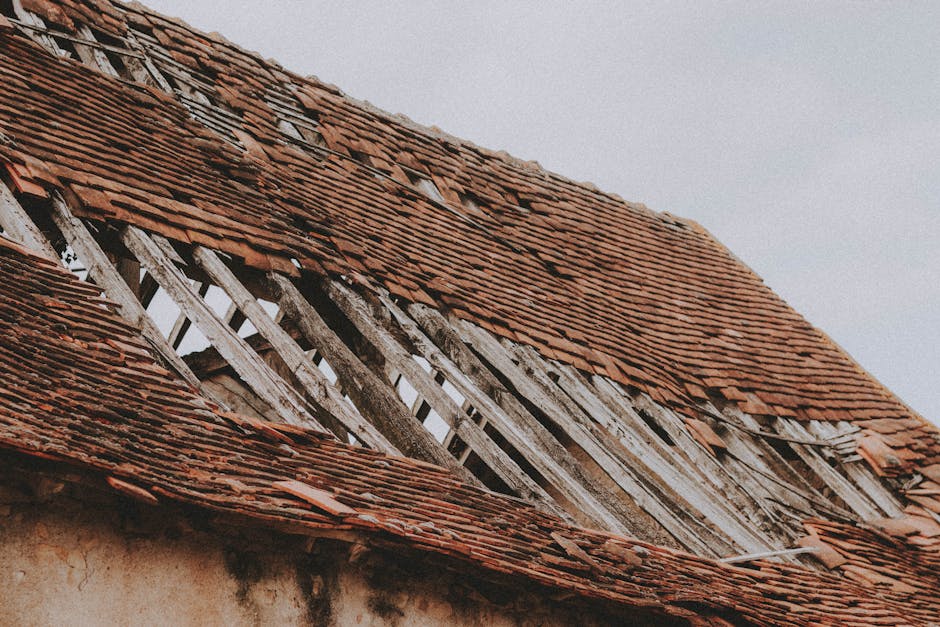Identifying and Addressing Storm Damage to Your Roof

A storm damaged roof can be a homeowner’s worst nightmare. When a severe storm hits, your roof takes the brunt of the impact, leaving it vulnerable to various types of damage. Knowing how to identify and address this damage quickly is crucial for maintaining your home’s integrity and safeguarding against further issues.
Quick Actions to Take for a Storm Damaged Roof:
1. Inspect for immediate dangers: Check for fallen tree branches or large debris.
2. Document all visible damage: Take photos or videos from a safe distance.
3. Contact your homeowner’s insurance company: Inform them of the damage and start the claims process.
4. Arrange for temporary repairs: Use tarps or covers to prevent further water damage.
Storm damage comes in many forms: from missing shingles and punctures to subtle issues like hail damage. Immediate action is vital. You’ll need to perform an initial inspection, contact your insurance company, and possibly get an adjuster or roofing contractor to assess the damage.
By staying proactive and informed, you can ensure that your storm-damaged roof is repaired efficiently and effectively, minimizing stress and costly repairs down the line.

Signs of Storm Damage on Your Roof
Storm damage can show up in many ways on your roof. Knowing what to look for can save you big headaches and costs later. Here’s a breakdown of the most common signs of damage from different types of storms.
Heavy Rain and Thunderstorms
Heavy rain and thunderstorms can wreak havoc on your roof. Water stains on your ceiling or walls are a clear sign that water has breached your roof. This often leads to ceiling leaks and wall damage.

If your roof doesn’t have proper drainage, standing water can create holes or weaken the adhesive between shingles, causing them to sag or become dislodged.
Hailstorms
Hailstorms, although usually shorter, can cause significant damage. Look for pock marks or dents on your shingles. These round-shaped marks often indicate hail damage.

Check for missing granules or piles of granules at the bottom of your roof. These granules protect your shingles from sun damage, and their loss can shorten your roof’s lifespan.
Windstorms
Windstorms can be tricky. They can lift, curl, or tear shingles, making your roof vulnerable to water leaks. If your roof has lifted shingles, curled shingles, or torn shingles, it’s time to call a professional.

You might also notice loose granules from the shingles. This is a sign that the wind has damaged the protective layer of your roof.
Ice Storms
Ice storms can cause ice damming, where ice prevents melting snow from draining off the roof. This leads to water seepage and roof leaks.

Check for water spots on your ceilings or walls, which indicate that water has found its way inside. Ice storms can also damage the flashing around vents and chimneys, leading to leaks.
By being aware of these signs, you can take quick action to address any storm damage and protect your home from further issues. Next, we’ll discuss the steps you should take after finding storm damage.
Steps to Take After Finding Storm Damage
Contact Your Homeowners Insurance Company
The first step after finding storm damage is to contact your homeowners insurance company. This is crucial to start the insurance claim process. Inform them about the damage and provide any initial details. Your insurance company will guide you on the next steps, which may include scheduling an inspection with an adjuster.
Document the Damage
Next, you need to document the damage thoroughly. Take clear photos and videos of all affected areas. This evidence is vital for your insurance claim. Make sure to capture details like:
- Missing or cracked shingles
- Water spots on ceilings or walls
- Damaged flashing around chimneys or vents
Keep detailed notes describing each type of damage. This documentation will help you when discussing your claim with the insurance adjuster.
Temporary Repairs
While waiting for the insurance process to unfold, you should make temporary repairs to prevent further damage. For example, you can use tarps to cover exposed areas of your roof. Remember to prioritize safety—avoid climbing onto the roof if it’s not safe. Instead, consider hiring a professional for temporary fixes.
Professional Inspection
After documenting the damage and making temporary repairs, contact a local roofing contractor for a professional inspection. A detailed assessment from a qualified contractor can help you understand the extent of the damage and the necessary repairs.
The contractor will also provide a report and photos to submit to your insurance company. This ensures that your claim is accurate and complete, increasing the likelihood of approval.
By following these steps, you can steer the aftermath of storm damage more effectively and ensure your home is restored promptly. Next, we’ll dive into the insurance claim process for a storm-damaged roof.
The Insurance Claim Process for a Storm Damaged Roof
Understanding the Process
The insurance claim process for a storm damaged roof can be muddy and confusing. Unfortunately, some roofing and insurance companies might not always have your best interest in mind. This complexity can be exploited by unscrupulous actors who take advantage of homeowners in distress.
Key Tip: Always be wary of potential scams and ensure you’re working with reputable contractors. Scams often involve offering low-quality work or falsely claiming the necessity of repairs to pocket the insurance money.
Avoid Signing Paperwork Prematurely
One major red flag is a contractor trying to get you to sign paperwork before your insurance claim is approved. This is often a tactic to lock you into a contract prematurely.
Important: Do not sign any contracts or agreements until your insurance claim is approved. A reputable contractor will wait until the insurance adjuster has inspected the damage and approved your claim.
Role of the Insurance Adjuster
The insurance adjuster plays a crucial role in the claim process. They are the only ones who can approve your claim. While a roofing contractor can inspect the damage and advocate for you, the final decision lies with the adjuster.
Note: Adjusters can make mistakes. If your claim is denied and you believe there is valid storm damage, request a second inspection. If the second adjuster also denies the claim, you can hire an engineer to provide further evidence.
Choosing the Right Roofing Contractor
Once your claim is approved, you have the freedom to choose any local roofing contractor. Here are some tips to ensure you select the right one:
- Local Contractors: Choose a contractor with a strong local presence. This ensures they are familiar with the area and are likely to be around if any issues arise later.
- Insurance Experience: Make sure the contractor has experience working with insurance claims. This can streamline the process and ensure all necessary documentation is provided.
- Quality Workmanship: Look for contractors known for high-quality work. Check reviews, ask for references, and ensure they use good materials.
Pro Tip: Don’t waste time getting multiple quotes to find the lowest price. The insurance company sets the price for your roof replacement. Instead, focus on finding a contractor who will do the job right.
By understanding these key points, you can steer the insurance claim process more effectively and ensure your storm-damaged roof is repaired professionally and promptly. Next, we’ll address some frequently asked questions about storm-damaged roofs.
Frequently Asked Questions about Storm Damaged Roofs
What does a storm damaged roof look like?
A storm damaged roof can show several signs. Look for granule loss on shingles, which can appear as bald spots. These granules protect your roof from the sun.
Shingle damage is another sign. This can include cracks, splits, or missing shingles. After a hailstorm, you might see impact marks or dents on the roof.
Pro Tip: Check your gutters for shingle granules. If your roof is over 10 years old and you see granules, it might be nearing the end of its lifespan.
Can roof damage be repaired?
Yes, roof damage can often be repaired, especially if it’s limited to a small area. Small area repair involves fixing or replacing a few damaged shingles. This is cost-effective if the rest of the roof is in good shape.
However, if the damage is extensive, a full roof replacement might be necessary. Extensive damage can include widespread shingle loss, significant granule loss, or structural damage. Always consider the cost of repairs versus replacement. If repair costs are close to replacement costs, a new roof might be the better option.
How much damage does a roof need to be replaced?
Determining if a roof needs replacement involves a thorough damage assessment. Roofers often use test squares to measure the extent of the damage. If a certain percentage of shingles in the test square are damaged, it may justify a full replacement.
Company standards and insurance guidelines also play a role. Some insurance policies might cover a replacement if damage exceeds a specific threshold. Always consult a professional for an accurate assessment.
Can thunderstorms damage the roof?
Yes, thunderstorms can cause significant damage to roofs. High winds can lift and remove shingles, exposing the underlayment. This can lead to leaks and further damage.
Shingle removal by wind is common, especially if the roofing material is lightweight like asphalt shingles. The underlayment exposure can cause water to seep into the roof structure, leading to rot and mold.
Pro Tip: After a thunderstorm, inspect your roof for missing or curled shingles. If you spot any, contact a roofing professional immediately.
Conclusion
At Texas Roof Shield, we understand the stress and urgency that comes with a storm-damaged roof. That’s why we offer end-to-end solutions to ensure your roof is restored to its best condition quickly and efficiently.
Our commitment to quality means we use only the highest-grade materials and employ skilled professionals who are experts in their field. Whether it’s a minor repair or a complete roof replacement, you can trust us to deliver exceptional results.
One of our standout offerings is our patented roof protectant. This innovative solution can extend the life of your roof by 10-15 years, effectively doubling its strength and making it virtually indestructible. The protectant is applied in just a few hours and costs significantly less than a full roof replacement, making it a smart investment for any homeowner.
Don’t wait for the next storm to find weaknesses in your roof. Take proactive steps now to protect your home and ensure peace of mind. Contact us today for a free consultation and let us help you safeguard your most valuable asset.
Pro Tip: Regular inspections and timely repairs can save you thousands of dollars in the long run. Trust Texas Roof Shield to keep your roof in top shape, no matter what Mother Nature throws your way.